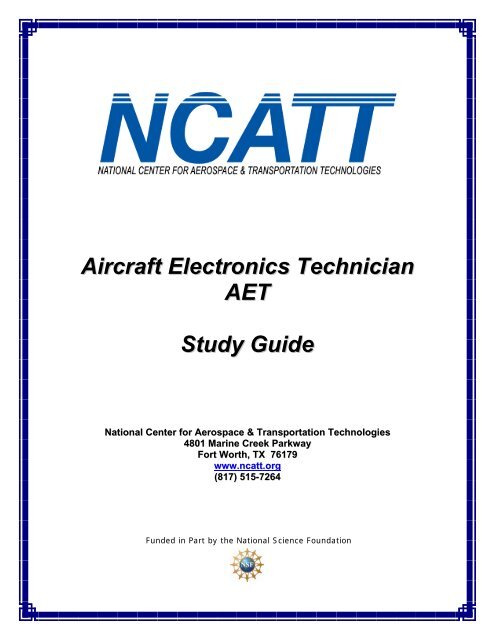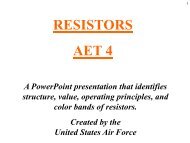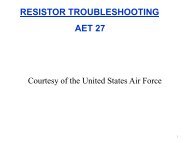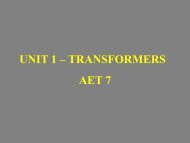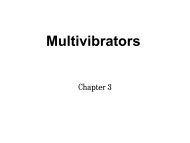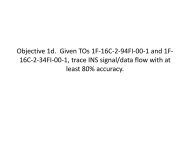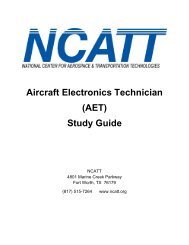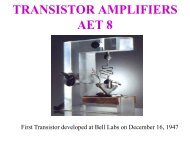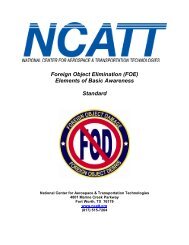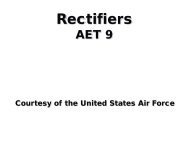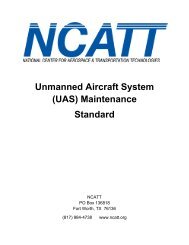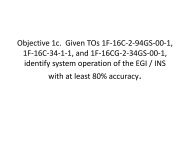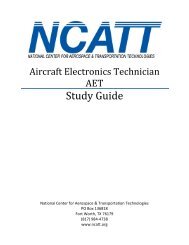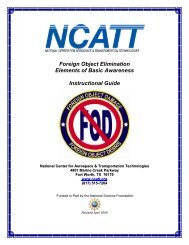Aircraft Electronics Technician AET Study Guide - NCATT
Aircraft Electronics Technician AET Study Guide - NCATT
Aircraft Electronics Technician AET Study Guide - NCATT
You also want an ePaper? Increase the reach of your titles
YUMPU automatically turns print PDFs into web optimized ePapers that Google loves.
<strong>Aircraft</strong> <strong>Electronics</strong> <strong>Technician</strong><br />
<strong>AET</strong><br />
<strong>Study</strong> <strong>Guide</strong><br />
National Center for Aerospace & Transportation Technologies<br />
4801 Marine Creek Parkway<br />
Fort Worth, TX 76179<br />
www.ncatt.org<br />
(817) 515-7264<br />
Funded in Part by the National Science Foundation
THIS PAGE INTENTIONALY LEFT BLANK
Page 1 of 17<br />
<strong>NCATT</strong><br />
<strong>Aircraft</strong> <strong>Electronics</strong> <strong>Technician</strong> (<strong>AET</strong>)<br />
<strong>Study</strong> <strong>Guide</strong><br />
Description<br />
This <strong>AET</strong> <strong>Study</strong> <strong>Guide</strong> is designed to be used in preparing for the <strong>NCATT</strong> <strong>AET</strong> Certification<br />
examination. The study guide addresses each <strong>NCATT</strong> <strong>AET</strong> knowledge “Standard” and the<br />
required level of understanding for passing the <strong>AET</strong> examination. The <strong>AET</strong> examination will ask<br />
one or more questions from each of the standards areas. Use of this study guide coupled with a<br />
serious review of the references and study materials that are provided on the <strong>NCATT</strong> website<br />
(www.ncatt.org) will ensure the technician is adequately prepared to join the ranks of “Certified<br />
<strong>Aircraft</strong> <strong>Electronics</strong> <strong>Technician</strong>s”.<br />
References<br />
• Applicable Textbooks<br />
• FAA Advisory Circulars<br />
• Manufacturer Technical Data<br />
• <strong>NCATT</strong> Web Resources www.ncatt.org<br />
Copyright © 2009 by National Center for Aerospace & Transportation Technologies. All rights reserved.<br />
Individuals may download, print, and make copies of this document<br />
for their own personal use. Commercial use prohibited.
Page 2 of 17<br />
Introductory and General Requirements<br />
1. Basic Terms and Definitions<br />
(a) Direct Current (DC) Terms<br />
Identify basic facts about and define direct current (DC) terms to include:<br />
• Direct current<br />
• Electron<br />
• Proton<br />
• Neutron<br />
• Conductor<br />
• Insulator<br />
• Static electricity<br />
• Current<br />
• Coulomb<br />
• Ampere<br />
• EMF<br />
• Volt<br />
• Resistance<br />
• Ohm<br />
• Watts<br />
• Capacitor<br />
• Inductor<br />
• Battery<br />
• Left-hand Rule<br />
• Magnetism<br />
• Magnetic permeability<br />
• Scientific notation<br />
• Metric prefixes<br />
• Henry<br />
• Farad<br />
1. Basic Terms and Definitions<br />
(b) Alternating Current (AC) Terms<br />
Identify the relationship of basic facts and state general principles about alternating current (AC)<br />
terms to include:<br />
• Alternating current<br />
• Frequency<br />
• Impedance<br />
• Capacitive reactance<br />
• Inductive reactance<br />
• Sine wave<br />
• RMS<br />
• Effective<br />
Copyright © 2009 by National Center for Aerospace & Transportation Technologies. All rights reserved.<br />
Individuals may download, print, and make copies of this document<br />
for their own personal use. Commercial use prohibited.
Page 3 of 17<br />
• Phase<br />
• Resistance<br />
• Power factor<br />
• True power<br />
• Apparent power<br />
• Wye wound<br />
• Delta wound<br />
• Polyphase<br />
• Rectifier<br />
2. Basic Circuits<br />
(a)Theory of Operations<br />
Identify the relationship of basic facts and state general principles about basic circuit theory of<br />
operation to include:<br />
• Volts<br />
• Amps<br />
• Resistance<br />
• Ohm’s Law<br />
• Power<br />
• Watts<br />
• Joules<br />
• Series circuits<br />
• Parallel circuits<br />
• Complex circuits<br />
• Voltage drop<br />
• Resistors in series circuits<br />
• Resistors in parallel circuits<br />
• Kirchoff’s Law<br />
• Bridge circuits<br />
2. Basic Circuits<br />
(b) Troubleshoot Circuits<br />
Determine procedures for troubleshooting basic electrical circuits to include:<br />
• Series circuit<br />
• Parallel circuit<br />
• Complex circuit voltage drop<br />
• Resistors in series circuit<br />
• Resistors in parallel circuit<br />
• Kirchoff’s Law<br />
• Bridge circuits<br />
3. Basic Circuit Calculations<br />
Copyright © 2009 by National Center for Aerospace & Transportation Technologies. All rights reserved.<br />
Individuals may download, print, and make copies of this document<br />
for their own personal use. Commercial use prohibited.
Page 4 of 17<br />
(a) DC<br />
Identify the relationship of basic facts and state general principles for DC circuit calculations to<br />
include:<br />
• Volts<br />
• Amps<br />
• Ohms<br />
• Watts<br />
3. Basic Circuit Calculations<br />
(b) AC<br />
Identify the relationship of basic facts and state general principles for AC circuit calculations to<br />
include:<br />
• Phase angle<br />
• Frequency<br />
• Capacitive reactance<br />
• Inductive reactance<br />
• Power factor<br />
• Period<br />
• Peak voltage<br />
• Effective (working) voltage<br />
• Inductance<br />
• Resonance<br />
• Capacitance<br />
• Impedance<br />
• True power<br />
• Apparent power<br />
3. Basic Circuit Calculations<br />
(c) DC/AC Measurements<br />
Determine procedures for calculating basic DC and AC measurements using:<br />
• Voltmeters<br />
• Ohmmeters<br />
• Oscilloscopes<br />
• Ammeters<br />
4. Resistors<br />
(a) Color Codes<br />
Identify basic facts and terms about resistor identification (values) using color codes.<br />
Copyright © 2009 by National Center for Aerospace & Transportation Technologies. All rights reserved.<br />
Individuals may download, print, and make copies of this document<br />
for their own personal use. Commercial use prohibited.
Page 5 of 17<br />
4. Resistors<br />
(b) Isolate Faulty Resistors<br />
Determine procedures for isolating faulty resistors within a circuit to include:<br />
• Open Resistors<br />
• Shorted Resistors<br />
• Resistors of incorrect value<br />
• Improperly installed Resistors<br />
5. Inductors<br />
(a) Theory of Operation<br />
Identify the relationship of basic facts and state general principles about inductor theory of<br />
operations to include:<br />
• Correct operation of Inductors (coils)<br />
• Use of multiple Inductors<br />
• Calculation of inductive reactance<br />
5. Inductors<br />
(b) Isolate Faulty Inductors<br />
Identify the relationship of basic facts and state general principles for isolating faulty inductors to<br />
include:<br />
• Open Inductors<br />
• Shorted Inductors<br />
• Improperly installed Inductors<br />
6. Capacitors<br />
(a) Theory of Operation<br />
Identify the relationship of basic facts and state general principles about capacitor theory of<br />
operation to include:<br />
• Correct operation of Capacitors<br />
• Use of multiple Capacitors<br />
• Calculation of capacitive reactance<br />
• Time constants<br />
• Fixed Capacitors<br />
• Variable Capacitors<br />
• Dielectric<br />
• Farad<br />
• Electrolytic<br />
Copyright © 2009 by National Center for Aerospace & Transportation Technologies. All rights reserved.<br />
Individuals may download, print, and make copies of this document<br />
for their own personal use. Commercial use prohibited.
Page 6 of 17<br />
6. Capacitors<br />
(b) Isolate Faulty Capacitors<br />
Determine procedures for isolating faulty capacitors in a circuit to include:<br />
• Open Capacitors<br />
• Shorted Capacitors<br />
• Improperly installed Capacitors<br />
7. Transformers<br />
(a) Theory of Operation<br />
Identify the relationship of basic facts and state general principles about transformer theory of<br />
operation to include:<br />
• Primary winding<br />
• Secondary winding<br />
• Eddy currents<br />
• Counter EMF<br />
• Step-up<br />
• Step-down<br />
• Hysteresis<br />
7. Transformers<br />
(b) Isolate Faulty Transformers<br />
Determine procedures for isolating faulty transformers within a circuit to include:<br />
• Open or shorted Primary Coil<br />
• Secondary Coil<br />
• Improperly installed Transformers<br />
• Primary and secondary resistance testing<br />
8. Analog Circuits, Devices and Switches<br />
Identify the relationship of basic facts and state general principles about use and operation of<br />
analog circuits, analog devices and analog switches to include:<br />
• Switches<br />
• Relays<br />
• Solenoids<br />
• Derating factors<br />
• Normally open<br />
• Normally closed<br />
• DPST<br />
• SPDT<br />
Copyright © 2009 by National Center for Aerospace & Transportation Technologies. All rights reserved.<br />
Individuals may download, print, and make copies of this document<br />
for their own personal use. Commercial use prohibited.
Page 7 of 17<br />
• DPDT<br />
• Rocker<br />
• Toggle<br />
• Rotary<br />
• Micro Switch<br />
• Push button Switch<br />
• Proximity switches<br />
9. Power Supply Circuits<br />
(a) Rectifiers<br />
Identify the relationship of basic facts and state general principles for power supply circuit<br />
rectifiers to include:<br />
• Use of power supply circuits<br />
• Types of components used<br />
• Solid-state<br />
• Silicon<br />
• Germanium<br />
• Forward bias<br />
• Reverse bias<br />
• Diode<br />
• Full-wave Rectifier<br />
• Half-wave Rectifier<br />
• Three phase Rectifier<br />
• Ripple amplitude<br />
9. Power Supply Circuits<br />
(b) Filters<br />
Identify basic facts and terms about power supply circuit filters to include:<br />
• Active filters<br />
• Passive filters<br />
10. Frequency Sensitive Filters<br />
Theory of Operation<br />
Identify basic facts and terms about the theory of operation for frequency sensitive filters to<br />
include:<br />
• Filtering<br />
• High-pass<br />
• Band-pass<br />
• Band-reject<br />
• Tuning circuit<br />
Copyright © 2009 by National Center for Aerospace & Transportation Technologies. All rights reserved.<br />
Individuals may download, print, and make copies of this document<br />
for their own personal use. Commercial use prohibited.
Page 8 of 17<br />
• Detection<br />
• Demodulation<br />
• Use of crystals<br />
• Cutoff frequency<br />
11. Wave Generation Circuits<br />
(a) Oscillators<br />
Identify basic facts and terms about the theory of operation for wave generation circuit oscillators<br />
to include:<br />
• Oscillator<br />
• LC tank<br />
• Crystal-controlled Oscillator<br />
• Hartley Oscillator<br />
• Regenerative feedback path<br />
11. Wave Generation Circuits<br />
(b) Wave shaping Circuits<br />
Identify basic facts and terms about the theory of operation for wave shaping circuits to include:<br />
• Oscillator<br />
• LC tank<br />
• Crystal-controlled Oscillator<br />
• Monostable Multivibrator<br />
• Astable Multivibrator<br />
• Bistable Multivibrator<br />
12. Limiter Circuits<br />
(a) Diodes<br />
Identify the relationship of basic facts and state general principles about operation of limiter<br />
circuit diodes to include:<br />
• Schematic diagram symbol<br />
• Proper use and installation<br />
• Forward bias<br />
• Reverse bias<br />
12. Limiter Circuits<br />
(b) Zener Diodes<br />
Identify the relationship of basic facts and state general principles about operation of limiter<br />
circuit zener diodes to include:<br />
Copyright © 2009 by National Center for Aerospace & Transportation Technologies. All rights reserved.<br />
Individuals may download, print, and make copies of this document<br />
for their own personal use. Commercial use prohibited.
Page 9 of 17<br />
• Schematic diagram symbol<br />
• Proper use and installation<br />
12. Limiter Circuits<br />
(c) Transistors<br />
Identify the relationship of basic facts and state general principles about operation of limiter<br />
circuit transistors to include:<br />
• Schematic diagram symbol<br />
• Proper use and installation<br />
• PNP<br />
• NPN<br />
• Polarity of connections<br />
• Bipolar<br />
• Collector current<br />
• Base current<br />
• Emitter current<br />
• Emitter Base Junction<br />
• Collector Base Junction<br />
13. Digital Numbering Systems<br />
(a) Binary<br />
Identify the relationship of basic facts and state general principles about binary digital numbering<br />
systems to include:<br />
• Digital signal<br />
• One<br />
• Zero<br />
• Conversion from/to digital and hexadecimal<br />
13. Digital Numbering Systems<br />
(b) Octal<br />
Identify the relationship of basic facts and state general principles about octal digital numbering<br />
systems to include:<br />
• Octal notation<br />
• Triad<br />
• Conversion from/to binary and decimal<br />
13. Digital Numbering Systems<br />
(c) Hexadecimal<br />
Copyright © 2009 by National Center for Aerospace & Transportation Technologies. All rights reserved.<br />
Individuals may download, print, and make copies of this document<br />
for their own personal use. Commercial use prohibited.
Page 10 of 17<br />
Identify the relationship of basic facts and state general principles about hexadecimal digital<br />
numbering systems to include:<br />
• Base 16<br />
• Hex to decimal conversion<br />
• Decimal to hex conversion<br />
14. Digital Logic Functions<br />
(a) Main Logic Gates<br />
Identify the relationship of basic facts and state general principles about digital logic functions<br />
utilizing main logic gates to include:<br />
• Positive and negative logic<br />
• Display of digital data<br />
• Truth tables<br />
• Logic gates<br />
• AND<br />
• OR<br />
• INVERT<br />
• NOR<br />
• NAND<br />
• Exclusive OR<br />
• Proper use and installation<br />
14. Digital Logic Functions<br />
(b) Flip-flops<br />
Identify the relationship of basic facts and state general principles about digital logic functions<br />
utilizing flip-flops to include:<br />
• Latches<br />
• RS latch<br />
• Data-type latch<br />
• Clock pulse<br />
• JK flip-flop<br />
• Asynchronous flip-flop<br />
• Advantages of flip-flops<br />
14. Digital Logic Functions<br />
(c) Counters<br />
Identify the relationship of basic facts and state general principles about digital logic functions<br />
utilizing counters to include:<br />
• Adder and subtractor circuits<br />
Copyright © 2009 by National Center for Aerospace & Transportation Technologies. All rights reserved.<br />
Individuals may download, print, and make copies of this document<br />
for their own personal use. Commercial use prohibited.
Page 11 of 17<br />
• Half-adder<br />
• Full-adder<br />
• Subtractor<br />
• Asynchronous<br />
• Synchronous<br />
• Frequency division characteristics<br />
• Counter triggering method<br />
14. Digital Logic Functions<br />
(d) Adders<br />
Identify the relationship of basic facts and state general principles about digital logic functions<br />
utilizing adders to include:<br />
• Adder<br />
• Half-adder<br />
• Full-adder<br />
Common Maintenance Practices<br />
15. Hazards/Safety Practices<br />
(a) RF Energy<br />
Identify basic facts and terms about hazards and safety practices concerning RF energy.<br />
15. Hazards/Safety Practices<br />
(b) Noise<br />
Identify basic facts and terms about hazards and safety practices concerning noise.<br />
15. Hazards/Safety Practices<br />
(c) Electrical Power<br />
Identify basic facts and terms about hazards and safety practices concerning electrical power to<br />
include:<br />
• Circuit protection devices<br />
• Elimination/termination of circuit power<br />
15. Hazards/Safety Practices<br />
(d) ESD Protection<br />
Identify basic facts and terms about hazards and safety practices concerning ESD protection.<br />
15. Hazards/Safety Practices<br />
(e) Microwave<br />
Copyright © 2009 by National Center for Aerospace & Transportation Technologies. All rights reserved.<br />
Individuals may download, print, and make copies of this document<br />
for their own personal use. Commercial use prohibited.
Page 12 of 17<br />
Identify basic facts and terms about hazards and safety practices concerning microwave energy.<br />
15. Hazards/Safety Practices<br />
(f) Hazardous Liquids<br />
Identify basic facts and terms about hazards and safety practices concerning hazardous liquids to<br />
include:<br />
• MEK<br />
• Acetone<br />
• Solvents<br />
• Cleaners and caustic solutions used in electronics<br />
• How to obtain proper Material Safety Data Sheet (MSDS) information<br />
15. Hazards/Safety Practices<br />
(g) Practice FOD Prevention<br />
Determine simple facts about practicing Foreign Object Damage (FOD) prevention to include:<br />
• Foreign Object Elimination (FOE)<br />
• Tool Control and management<br />
• Housekeeping<br />
15. Hazards/Safety Practices<br />
(h) First Aid for Electrical Shock<br />
Identify basic facts and terms about First Aid for electrical shock to include:<br />
• Proper steps to take in case of need for First Aid<br />
• How to rescue someone hurt by electrical shock<br />
• First Aid and CPR<br />
16. Hazardous Materials Handling<br />
(a) Types of Hazardous Materials/Fluids<br />
Identify basic facts and terms about hazardous materials and fluids to include:<br />
• OSHA standard 29 CFR 1910.1200<br />
• Use of MSDS (See 16e.)<br />
• Handling of chemicals<br />
• Physical health hazards<br />
• Explosive health hazards<br />
• Workplace communication programs<br />
Copyright © 2009 by National Center for Aerospace & Transportation Technologies. All rights reserved.<br />
Individuals may download, print, and make copies of this document<br />
for their own personal use. Commercial use prohibited.
Page 13 of 17<br />
16. Hazardous Materials Handling<br />
(b) Handling Procedures<br />
Identify basic facts and terms about handling hazardous materials.<br />
16. Hazardous Materials Handling<br />
(c) Storage and Labeling<br />
Identify basic facts and terms about storage and labeling of hazardous materials.<br />
16. Hazardous Materials Handling<br />
(d) Proper Disposal<br />
Identify basic facts and terms about proper disposal of hazardous materials.<br />
16. Hazardous Materials Handling<br />
(e) Material Safety Data Sheet (MSDS)<br />
Identify basic facts and terms about use of Material Safety Data Sheets.<br />
Copyright © 2009 by National Center for Aerospace & Transportation Technologies. All rights reserved.<br />
Individuals may download, print, and make copies of this document<br />
for their own personal use. Commercial use prohibited.
Page 14 of 17<br />
17. Technical Publications<br />
(a) Interpret Installation Manuals<br />
Identify basic facts and terms about interpreting installation manuals.<br />
17. Technical Publications<br />
(b) Interpret Technical Data<br />
Identify basic facts and terms about interpreting technical data to include:<br />
• Schematic diagrams<br />
• Wiring diagrams<br />
• Block diagrams<br />
• Pictorial diagrams<br />
17. Technical Publications<br />
(c) Locate and interpret avionics installation data<br />
Identify basic facts and terms about locating and interpreting avionics installation data to include:<br />
• Approved flight manual supplements<br />
• <strong>Aircraft</strong> maintenance records<br />
• <strong>Aircraft</strong> equipment lists<br />
• <strong>Aircraft</strong> weight and balance<br />
• Supplemental Type Certificates (STC’s)<br />
17. Technical Publications<br />
(d) Interpret wiring diagrams<br />
Identify basic facts and terms about interpreting wiring diagrams.<br />
17. Technical Publications<br />
(e) Interpret charts/blueprints/drawings/sketches<br />
Identify basic facts and terms about interpreting charts, blueprints, drawings and sketches.<br />
Copyright © 2009 by National Center for Aerospace & Transportation Technologies. All rights reserved.<br />
Individuals may download, print, and make copies of this document<br />
for their own personal use. Commercial use prohibited.
Page 15 of 17<br />
17. Technical Publications<br />
(f) Interpret <strong>Aircraft</strong> Equipment List Information<br />
Identify basic facts and terms about interpreting aircraft equipment list information.<br />
Fundamentals of On-Equipment Maintenance<br />
18. Use Common Tools<br />
Determine procedures for using common tools.<br />
19. Handling of Electrostatic Devices<br />
Identify basic facts and terms about handling of electrostatic devices.<br />
20. Identify and Perform<br />
Corrosion Control<br />
Identify simple facts about identification of corrosion and performance corrosion control to<br />
include:<br />
• Galvanic<br />
• Pitting<br />
• Exfoliation<br />
• Intergranular<br />
21. Use Safetying Devices<br />
(a) Safety Wire<br />
Identify simple facts about use of safety wire to include:<br />
• All types of safety devices<br />
• Types and sizes of safety wire<br />
• Acceptable safety wire practices<br />
21. Use of Safetying Devices<br />
(b) Shear Wire<br />
Identify simple facts about use of shear wire.<br />
22. <strong>Aircraft</strong> Wiring<br />
(a) Multiconductor<br />
Identify basic facts and terms about use of multiconductor aircraft wire.<br />
Copyright © 2009 by National Center for Aerospace & Transportation Technologies. All rights reserved.<br />
Individuals may download, print, and make copies of this document<br />
for their own personal use. Commercial use prohibited.
Page 16 of 17<br />
22. <strong>Aircraft</strong> Wiring<br />
(b) Coaxial<br />
Identify basic facts and terms about use of coaxial aircraft wire.<br />
22. <strong>Aircraft</strong> Wiring<br />
(c) Twisted Pair<br />
Identify basic facts and terms about use of twisted pair aircraft wire.<br />
22. <strong>Aircraft</strong> Wiring<br />
(d) Single Conductor<br />
Identify basic facts and terms about use of single conductor aircraft wire.<br />
23. Perform Wire Maintenance<br />
Continuity Checks<br />
Use multimeter or appropriate tooling to perform continuity checks on wiring or electrical<br />
equipment.<br />
24. Use Test Equipment/Special Tools<br />
(a) Analog Multimeters<br />
(b) Digital Multimeters<br />
(c) Oscilloscope<br />
Determine procedures for using test equipment and special tools.<br />
<strong>Aircraft</strong> Fundamentals<br />
25. Aviation Terminology<br />
Identify basic facts and terms about aircraft design and construction techniques to include:<br />
• Fuselage<br />
• Wings<br />
• Empennage components<br />
• Internal and external bracing for structural integrity<br />
• Streamlining and drag reduction for airframes and structures<br />
• <strong>Aircraft</strong> axis and controls<br />
• Aerodynamic forces<br />
Copyright © 2009 by National Center for Aerospace & Transportation Technologies. All rights reserved.<br />
Individuals may download, print, and make copies of this document<br />
for their own personal use. Commercial use prohibited.
Page 17 of 17<br />
26. Basic Aviation/<strong>Aircraft</strong><br />
Fundamentals and Safety<br />
Identify basic facts and terms about aviation/aircraft fundamentals and safe ground operations to<br />
include:<br />
• Ground movement of aircraft<br />
• Storage of aircraft (e.g. preparation for and removal from storage)<br />
• <strong>Aircraft</strong> pre- and post-flight inspection<br />
27. Basic Troubleshooting Theory<br />
Identify basic facts and terms about troubleshooting theory to include:<br />
28. Identify Flight Controls<br />
• Use of basic troubleshooting tools (e.g. multimeter, continuity testers,<br />
oscilloscope)<br />
• Steps in troubleshooting process<br />
Identify basic facts and terms about identification of flight controls to include:<br />
• Theory of flight (e.g. Bernoulli’s Principal, Newton’s Laws of Motion,<br />
airfoils, forces that act on the aircraft in flight)<br />
• Flight controls (e.g. primary, secondary, auxiliary)<br />
29. Safety (Operational Risk<br />
Management/Fall Protection)<br />
Identify basic facts and terms about operation risk management/fall protection to include:<br />
• Causes of accidents (as related to the human element)<br />
• Proper techniques for lifting or moving objects<br />
Copyright © 2009 by National Center for Aerospace & Transportation Technologies. All rights reserved.<br />
Individuals may download, print, and make copies of this document<br />
for their own personal use. Commercial use prohibited.


